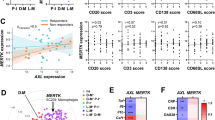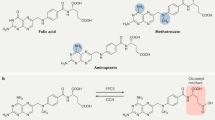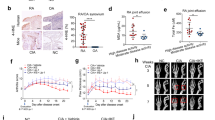Abstract
Activation of synovial fibroblasts (SFs) contributes to rheumatoid arthritis (RA) by damaging synovial membranes and generating inflammatory cytokines that recruit immune cells to the joint. In this paper we profile cytokine secretion by primary human SFs from healthy tissues and from donors with RA and show that SF activation by TNF, IL-1α, and polyinosinic-polycytidylic acid (Poly(I:C)) cause secretion of multiple cytokines found at high levels in RA synovial fluids. We used interaction multiple linear regression to quantify therapeutic and countertherapeutic drug effects across activators and donors and found that the ability of drugs to block SF activation was strongly dependent on the identity of the activating cytokine. (5z)-7-oxozeaenol (5ZO), a preclinical drug that targets transforming growth factor-β–activated kinase 1 (TAK1), was more effective at blocking SF activation across all contexts than the approved drug tofacitinib, which supports the development of molecules similar to 5ZO for use as RA therapeutics.
This is a preview of subscription content, access via your institution
Access options
Subscribe to this journal
Receive 12 print issues and online access
$259.00 per year
only $21.58 per issue
Buy this article
- Purchase on Springer Link
- Instant access to full article PDF
Prices may be subject to local taxes which are calculated during checkout






Similar content being viewed by others
References
Scott, D.L., Wolfe, F. & Huizinga, T.W. Rheumatoid arthritis. Lancet 376, 1094–1108 (2010).
McInnes, I.B. & Schett, G. The pathogenesis of rheumatoid arthritis. N. Engl. J. Med. 365, 2205–2219 (2011).
Taylor, P.C. & Feldmann, M. Anti-TNF biologic agents: still the therapy of choice for rheumatoid arthritis. Nat. Rev. Rheumatol. 5, 578–582 (2009).
Emery, P. et al. IL-6 receptor inhibition with tocilizumab improves treatment outcomes in patients with rheumatoid arthritis refractory to anti-tumour necrosis factor biologicals: results from a 24-week multicentre randomised placebo-controlled trial. Ann. Rheum. Dis. 67, 1516–1523 (2008).
Stanczyk, J., Ospelt, C. & Gay, S. Is there a future for small molecule drugs in the treatment of rheumatic diseases? Curr. Opin. Rheumatol. 20, 257–262 (2008).
Lindstrom, T.M. & Robinson, W.H. A multitude of kinases—which are the best targets in treating rheumatoid arthritis? Rheum. Dis. Clin. North Am. 36, 367–383 (2010).
Arthur, J.S.C. & Ley, S.C. Mitogen-activated protein kinases in innate immunity. Nat. Rev. Immunol. 13, 679–692 (2013).
Neumann, E., Lefèvre, S., Zimmermann, B., Gay, S. & Müller-Ladner, U. Rheumatoid arthritis progression mediated by activated synovial fibroblasts. Trends Mol. Med. 16, 458–468 (2010).
Bottini, N. & Firestein, G.S. Duality of fibroblast-like synoviocytes in RA: passive responders and imprinted aggressors. Nat. Rev. Rheumatol. 9, 24–33 (2013).
Noss, E.H. & Brenner, M.B. The role and therapeutic implications of fibroblast-like synoviocytes in inflammation and cartilage erosion in rheumatoid arthritis. Immunol. Rev. 223, 252–270 (2008).
Lefèvre, S. et al. Synovial fibroblasts spread rheumatoid arthritis to unaffected joints. Nat. Med. 15, 1414–1420 (2009).
Müller-Ladner, U. et al. Synovial fibroblasts of patients with rheumatoid arthritis attach to and invade normal human cartilage when engrafted into SCID mice. Am. J. Pathol. 149, 1607–1615 (1996).
Bartok, B. & Firestein, G.S. Fibroblast-like synoviocytes: key effector cells in rheumatoid arthritis. Immunol. Rev. 233, 233–255 (2010).
Janes, K.A. et al. A systems model of signaling identifies a molecular basis set for cytokine-induced apoptosis. Science 310, 1646–1653 (2005).
Scheller, J., Chalaris, A., Schmidt-Arras, D. & Rose-John, S. The pro- and anti-inflammatory properties of the cytokine interleukin-6. Biochim. Biophys. Acta 1813, 878–888 (2011).
Baggiolini, M. & Clark-Lewis, I. Interleukin-8, a chemotactic and inflammatory cytokine. FEBS Lett. 307, 97–101 (1992).
Moser, B., Clark-Lewis, I., Zwahlen, R. & Baggiolini, M. Neutrophil-activating properties of the melanoma growth-stimulatory activity. J. Exp. Med. 171, 1797–1802 (1990).
Schumacher, C., Clark-Lewis, I., Baggiolini, M. & Moser, B. High- and low-affinity binding of GRO alpha and neutrophil-activating peptide 2 to interleukin 8 receptors on human neutrophils. Proc. Natl. Acad. Sci. USA 89, 10542–10546 (1992).
Carr, M.W., Roth, S.J., Luther, E., Rose, S.S. & Springer, T.A. Monocyte chemoattractant protein 1 acts as a T-lymphocyte chemoattractant. Proc. Natl. Acad. Sci. USA 91, 3652–3656 (1994).
Xu, L.L., Warren, M.K., Rose, W.L., Gong, W. & Wang, J.M. Human recombinant monocyte chemotactic protein and other C-C chemokines bind and induce directional migration of dendritic cells in vitro. J. Leukoc. Biol. 60, 365–371 (1996).
Maghazachi, A.A., Al-Aoukaty, A. & Schall, T.J. CC chemokines induce the generation of killer cells from CD56+ cells. Eur. J. Immunol. 26, 315–319 (1996).
Conti, P. & DiGioacchino, M. MCP-1 and RANTES are mediators of acute and chronic inflammation. Allergy Asthma Proc. 22, 133–137 (2001).
Taub, D.D. et al. Recombinant human interferon-inducible protein 10 is a chemoattractant for human monocytes and T lymphocytes and promotes T cell adhesion to endothelial cells. J. Exp. Med. 177, 1809–1814 (1993).
de Jager, W., Prakken, B.J., Bijlsma, J.W.J., Kuis, W. & Rijkers, G.T. Improved multiplex immunoassay performance in human plasma and synovial fluid following removal of interfering heterophilic antibodies. J. Immunol. Methods 300, 124–135 (2005).
Ellingsen, T., Buus, A. & Stengaard-Pedersen, K. Plasma monocyte chemoattractant protein 1 is a marker for joint inflammation in rheumatoid arthritis. J. Rheumatol. 28, 41–46 (2001).
Boiardi, L. et al. Relationship between serum RANTES levels and radiological progression in rheumatoid arthritis patients treated with methotrexate. Clin. Exp. Rheumatol. 17, 419–425 (1999).
Opdenakker, G., Froyen, G., Fiten, P., Proost, P. & Van Damme, J. Human monocyte chemotactic protein-3 (MCP-3): molecular cloning of the cDNA and comparison with other chemokines. Biochem. Biophys. Res. Commun. 191, 535–542 (1993).
Souza, L.M. et al. Recombinant human granulocyte colony-stimulating factor: effects on normal and leukemic myeloid cells. Science 232, 61–65 (1986).
Bacher, M. et al. An essential regulatory role for macrophage migration inhibitory factor in T-cell activation. Proc. Natl. Acad. Sci. USA 93, 7849–7854 (1996).
Calandra, T., Bernhagen, J., Mitchell, R.A. & Bucala, R. The macrophage is an important and previously unrecognized source of macrophage migration inhibitory factor. J. Exp. Med. 179, 1895–1902 (1994).
Malemud, C.J. Growth hormone, VEGF and FGF: involvement in rheumatoid arthritis. Clin. Chim. Acta 375, 10–19 (2007).
Davis, M.I. et al. Comprehensive analysis of kinase inhibitor selectivity. Nat. Biotechnol. 29, 1046–1051 (2011).
Zhang, T. et al. Discovery of potent and selective covalent inhibitors of JNK. Chem. Biol. 19, 140–154 (2012).
Ninomiya-Tsuji, J. et al. The kinase TAK1 can activate the NIK-IκB as well as the MAP kinase cascade in the IL-1 signalling pathway. Nature 398, 252–256 (1999).
Sakurai, H. Targeting of TAK1 in inflammatory disorders and cancer. Trends Pharmacol. Sci. 33, 522–530 (2012).
Ajibade, A.A ., Wang, H. Y., Wang, R.F. Cell type-specific function of TAK1 in innate immune signaling. Trends Immunol. 34, 307–316 (2013).
Cohen, J. Multiple regression as a general data-analytic system. Psychol. Bull. 70, 426–443 (1968).
Jaccard, J., Wan, C.K. & Turrisi, R. The detection and interpretation of interaction effects between continuous variables in multiple regression. Multivariate Behav. Res. 25, 467–478 (1990).
Jaccard, J. & Turrisi, R. Interaction Effects in Multiple Regression (SAGE Publications, 2003).
Takeda, K. & Akira, S. TLR signaling pathways. Semin. Immunol. 16, 3–9 (2004).
Li, X. & Qin, J. Modulation of Toll-interleukin 1 receptor mediated signaling. J. Mol. Med. 83, 258–266 (2005).
Tan, L. et al. Discovery of type II inhibitors of TGFβ-activated kinase 1 (TAK1) and mitogen-activated protein kinase kinase kinase kinase 2 (MAP4K2). J. Med. Chem. 58, 183–196 (2015).
Filer, A. The fibroblast as a therapeutic target in rheumatoid arthritis. Curr. Opin. Pharmacol. 13, 413–419 (2013).
Knight, Z.A., Lin, H. & Shokat, K.M. Targeting the cancer kinome through polypharmacology. Nat. Rev. Cancer 10, 130–137 (2010).
Shaw, S.Y. et al. Perturbational profiling of nanomaterial biologic activity. Proc. Natl. Acad. Sci. USA 105, 7387–7392 (2008).
Kahle, P. et al. Determination of cytokines in synovial fluids: correlation with diagnosis and histomorphological characteristics of synovial tissue. Ann. Rheum. Dis. 51, 731–734 (1992).
Rosengren, S., Boyle, D.L. & Firestein, G.S. Acquisition, culture, and phenotyping of synovial fibroblasts. Methods Mol. Med. 135, 365–375 (2007).
Millard, B.L., Niepel, M., Menden, M.P., Muhlich, J.L. & Sorger, P.K. Adaptive informatics for multifactorial and high-content biological data. Nat. Methods 8, 487–493 (2011).
Niepel, M. et al. Profiles of basal and stimulated receptor signaling networks predict drug response in breast cancer lines. Sci. Signal. 6, ra84 (2013).
Todd, D.J. et al. Erroneous augmentation of multiplex assay measurements in patients with rheumatoid arthritis due to heterophilic binding by serum rheumatoid factor. Arthritis Rheum. 63, 894–903 (2011).
Benjamini, Y. & Hochberg, Y. Controlling the false discovery rate: a practical and powerful approach to multiple testing. J. R. Stat. Soc. Series B Stat. Methodol. 57, 289–300 (1995).
Burnham, K.P. & Anderson, D.R. Model Selection and Multimodel Inference (Springer Science & Business Media, 2007).
Acknowledgements
We thank S. Rudnicki and the HMS ICCB for automation assistance; B. Joughin, D. Clarke, M. Morris, J. Copeland, G. Nabozny, D. Klatte, and S. Pullen for helpful discussions; and N. Gray and T. Zhang at DFCI (Boston, Massachusetts, USA) for providing JNK-IN-8. This work was supported by the NIH (LINCS grant U54HL127365 to P.K.S., grant P50 GM107618 to P.K.S., and NRSA Fellowship 5F32AR062931 to D.S.J.) and by a sponsored research agreement dated 1 August 2009 from Boehringer Ingelheim Inc. to P.K.S. and D.A.L.
Author information
Authors and Affiliations
Contributions
D.S.J. performed experiments and computational analyses, analyzed the results, and wrote and edited the paper; A.P.J. performed experiments; D.A.L. and P.K.S. analyzed the results and wrote and edited the paper; J.M.B. and J.L.S. made key intellectual contributions.
Corresponding author
Ethics declarations
Competing interests
J.M.B. and J.L.S. were employees at Boehringer Ingelheim Pharmaceuticals Inc. during the course of the studies; D.A.L. and P.K.S. were consultants to Boehringer Ingelheim Pharmaceuticals Inc.
Supplementary information
Supplementary Text and Figures
Supplementary Results, Supplementary Tables 1–7 and Supplementary Figures 1–18. (PDF 12484 kb)
Supplementary Data 1
SF donor sample N2586. (XLS 602 kb)
Supplementary Data 2
SF donor sample N2645. (XLS 602 kb)
Supplementary Data 3
SF donor sample N2759. (XLS 602 kb)
Supplementary Data 4
SF donor sample RA1869. (XLS 602 kb)
Supplementary Data 5
SF donor sample RA1931. (XLS 602 kb)
Supplementary Data 6
SF donor sample RA2159. (XLS 602 kb)
Supplementary Data 7
SF donor sample RA2708. (XLS 602 kb)
Supplementary Data 8
SF donor sample N2586. (XLS 175 kb)
Supplementary Data 9
SF donor sample N2645. (XLS 175 kb)
Supplementary Data 10
SF donor sample N2759. (XLS 175 kb)
Supplementary Data 11
SF donor sample RA1869. (XLS 175 kb)
Supplementary Data 12
SF donor sample RA1931. (XLS 175 kb)
Supplementary Data 13
SF donor sample RA2159. (XLS 175 kb)
Supplementary Data 14
SF donor sample RA2708. (XLS 175 kb)
Rights and permissions
About this article
Cite this article
Jones, D., Jenney, A., Swantek, J. et al. Profiling drugs for rheumatoid arthritis that inhibit synovial fibroblast activation. Nat Chem Biol 13, 38–45 (2017). https://doi.org/10.1038/nchembio.2211
Received:
Accepted:
Published:
Issue Date:
DOI: https://doi.org/10.1038/nchembio.2211
This article is cited by
-
Signaling pathways in rheumatoid arthritis: implications for targeted therapy
Signal Transduction and Targeted Therapy (2023)
-
Dynamic synovial fibroblasts are modulated by NBCn1 as a potential target in rheumatoid arthritis
Experimental & Molecular Medicine (2022)
-
Combination of subtherapeutic anti-TNF dose with dasatinib restores clinical and molecular arthritogenic profiles better than standard anti-TNF treatment
Journal of Translational Medicine (2021)
-
Fibroblasts as immune regulators in infection, inflammation and cancer
Nature Reviews Immunology (2021)
-
Suppression of monosodium urate crystal-induced inflammation by inhibiting TGF-β-activated kinase 1-dependent signaling: role of the ubiquitin proteasome system
Cellular & Molecular Immunology (2021)



